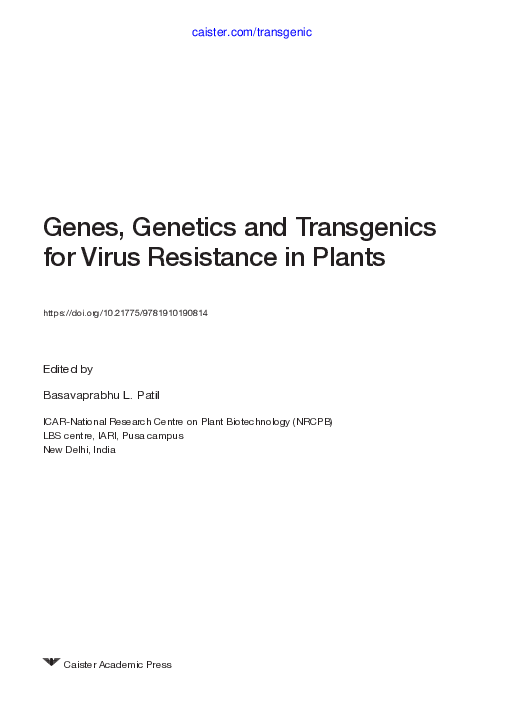Academia.edu no longer supports Internet Explorer.
To browse Academia.edu and the wider internet faster and more securely, please take a few seconds to upgrade your browser.
Virus resistant transgenic tomato: current status and future prospects
Virus resistant transgenic tomato: current status and future prospects
2018, Genes, Genetics and Transgenics for Virus Resistance in Plants
Related Papers
Biotecnología …
Transgenic Tobacco Cells: a Permissive System for the Assessment of Resistance Strategies Against Tomato Yellow Leaf Curl Virus2009 •
Journal of Experimental Botany
The TYLCV-tolerant tomato line MP-1 is characterized by superior transformation competence1997 •
Acta horticulturae
Preliminary results on development of transgenic tomato plants tolerant to Tomato yellow leaf curl virusInternational Journal of Molecular Sciences
Advances and Prospects of Virus-Resistant Breeding in TomatoesPlant viruses are the main pathogens which cause significant quality and yield losses in tomato crops. The important viruses that infect tomatoes worldwide belong to five genera: Begomovirus, Orthotospovirus, Tobamovirus, Potyvirus, and Crinivirus. Tomato resistance genes against viruses, including Ty gene resistance against begomoviruses, Sw gene resistance against orthotospoviruses, Tm gene resistance against tobamoviruses, and Pot 1 gene resistance against potyviruses, have been identified from wild germplasm and introduced into cultivated cultivars via hybrid breeding. However, these resistance genes mainly exhibit qualitative resistance mediated by single genes, which cannot protect against virus mutations, recombination, mixed-infection, or emerging viruses, thus posing a great challenge to tomato antiviral breeding. Based on the epidemic characteristics of tomato viruses, we propose that future studies on tomato virus resistance breeding should focus on rapidly, safely, and e...
2005 •
Tomato hybrids obtained from homozygous progeny of line 30-4, engineered for Tomato spotted wilt virus (TSWV) resistance, were tested under field conditions in two locations with their corresponding nontransgenic hybrids. No transgenic hybrid became infected, but 33 to 50% of plants of each nontransgenic hybrid became infected with a severe reduction of marketable fruit production. The transgenic hybrids conformed to the standard agronomic characteristics of the corresponding nontransgenic ones. Fruit were collected from the nontransgenic plots included in the experimental field and from border rows, and seed were used to estimate the flow of the transgene via pollen. No transgene flow was detected in the protected crops; however, in the open field experiment, 0.32% of tomato seedlings were found to contain the genetic modification. Immunity to TSWV infection in 30-4 hybrids was confirmed in laboratory conditions using mechanical inoculation and grafting. Thrips inoculation in leaf ...
2020 •
Grafting is routinely implemented in modern agriculture to manage soilborne pathogens such as fungi, oomycetes, bacteria, and viruses of solanaceous crops in a sustainable and environmentally friendly approach. Some rootstock/scion combinations use specific genetic resistance mechanisms to impact also some foliar and airborne pathogens, including arthropod or contact-transmitted viruses. These approaches resulted in poor efficiency in the management of plant viruses with superior virulence such as the strains of tomato spotted wilt virus breaking the Sw5 resistance, strains of cucumber mosaic virus carrying necrogenic satellite RNAs, and necrogenic strains of potato virus Y. Three different studies from our lab documented that suitable levels of resistance/tolerance can be obtained by grafting commercial tomato varieties onto the tomato ecotype Manduria (Ma) rescued in the framework of an Apulian (southern Italy) regional program on biodiversity. Here we review the main approaches, ...
Jarq-japan Agricultural Research Quarterly
Evaluation of the Impact of the Release of Transgenic Tomato Plants with TMV Resistance on the Environment1993 •
Molecular Breeding
Extreme resistance to cucumber mosaic virus (CMV) in transgenic tomato expressing one or two viral coat proteins1999 •
For the production of broad commercial resistance to cucumber mosaic virus (CMV) infection, tomato plants were transformed with a combination of two coat protein (CP) genes, representing both subgroups of CMV. The CP genes were cloned from the CMV-D strain and Italian CMV isolates (CMV-22 of subgroup I and CMV-PG of subgroup II) which have been shown to produce severe disease symptoms. Four plant transformation vectors were constructed: pMON18774 and pMON18775 (CMV-D CP), pMON18831 (CMV-PG CP) and pMON18833 (CMV-22 CP and CMV-PG CP). Transformed R0 plants were produced and lines were selected based on the combination of three traits: CMV CP expression at the R0 stage, resistance to CMV (subgroup I and/or II) infection in growth chamber tests in R1 expressing plants, and single transgene copy, based on R1 segregation. The results indicate that all four vector constructs generated plants with extremely high resistant to CMV infection. The single and double gene vector construct produced plants with broad resistance against strains of CMV from both subgroups I and II at high frequency. The engineered resistance is of practical value and will be applied for major Italian tomato varieties.
RELATED PAPERS
Frontiers in Public Health
Community integration, quality of life, thriving, and mental health among refugees and asylum seekers. A London service provider perspective2024 •
Diseases of The Esophagus
Texture analysis of computed tomography data using morphologic and metabolic delineation of esophageal cancer—relation to tumor type and neoadjuvant therapy response2018 •
Annals of emergency medicine
Transgender and Gender-Nonconforming Patients in the Emergency Department: What Physicians Know, Think, and Do2017 •
American Journal of Obstetrics and Gynecology
The transfer of glyburide across human placenta obtained from healthy and diabetic patients and the role of human serum albumin2005 •
Semiconductor Science and Technology
Efficient and stable polymer solar cells prepared using plasmonic graphene oxides as anode buffers2015 •
Journal of psychopharmacology (Oxford, England)
Adjunctive metformin for antipsychotic-related hyperprolactinemia: A meta-analysis of randomized controlled trials2017 •
International Journal of Science and Research (IJSR)
Efficient Hardware Encryption Using Lightweight Process2015 •
2019 •
Hygeia : Revista Brasileira de Geografia Médica e da Saúde
Utilização Do Sistema De Informação Geográfica Para Análise Do Câncer Em Santa Catarina2015 •
Circulation Research
Electrophysiological Characteristics of Canine Atrial Plateau Fibers1971 •

 Gustavo Fermin
Gustavo Fermin